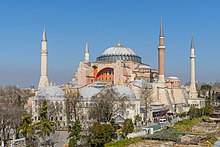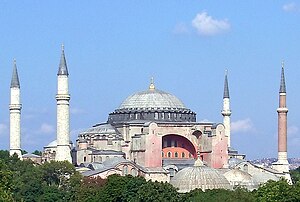ஹேகியா சோபியா
ஹேகியா சோபியா (/ˈhɑː.ɪə soʊˈfi.ə/; கிரேக்க மொழி: Ἁγία Σοφία, "புனித ஞானம்"; இலத்தீன்: Sancta Sophia / Sancta Sapientia; துருக்கியம்: Ayasofya) துருக்கியின் தலைநகரமான இஸ்தான்புல்லில் உள்ளது. முன்னர் கிழக்கத்திய மரபுவழிக் கிறித்தவப் பிரிவினரின் பெருங்கோவிலாக விளங்கிய இது, பின்னர் 1453 இல், மசூதியாக மாற்றப்பட்டது. 1935 ஆம் ஆண்டில் இது ஒரு அருங்காட்சியகம் ஆக்கப்பட்டு, அயசோஃப்யா அருங்காட்சியகம் என அழைக்கப்படுகின்றது. இது உலகின் சிறந்த கட்டிடங்களுள் ஒன்றாக மதிக்கப்படுகின்றது. எட்டாவது அதிசயம் என வர்ணிக்கப்படும் கட்டிடங்களில் இதுவும் ஒன்று. ஓட்டோமான் பேரரசு நிகழ்த்திய படையெடுப்பைத் தொடர்ந்து காண்ஸ்டாண்டிநோபுள் வீழ்ச்சியுற்றபோது, இப்பெருங்கோவிலை ஓட்டோமான்கள் கைப்பற்றினர். இதன் விளைவாகக் கிறித்தவம் நலிவடையத் தொடங்கியது.
 ஹேகியா சோபியாவின் ஒரு தோற்றம் | |
| ஆள்கூறுகள் | 41°00′31″N 28°58′48″E / 41.008548°N 28.979938°E |
|---|---|
| இடம் | காண்ஸ்டாண்டிநோபுள் (இன்றைய இசுதான்புல், துருக்கி) |
| வடிவமைப்பாளர் | இசிடோர் மைலீட்டசு (Isidore of Miletus) திரால்லசு நகர அந்தேமியசு |
| வகை | கீழை மரபுவழிப் பெருங்கோவில்: கி.பி. 537–1204 உரோமன் கத்தோலிக்கப் பெருங்கோவில் (1204–1261) |
| கட்டுமானப் பொருள் | செதுக்குக் கல், செங்கல் |
| நீளம் | 82 m (269 அடி) |
| அகலம் | 73 m (240 அடி) |
| உயரம் | 55 m (180 அடி) |
| துவங்கிய நாள் | 532 |
| முடிவுற்ற நாள் | 537 |


தொடக்க கால வரலாறு
தொகுஇக்கட்டடத்தை உருவாக்கும் பணி கி.பி. 532-537இல் நடந்தது. அதிலிருந்து கி.பி. 1453ஆம் ஆண்டுவரை அக்கட்டடம் கீழை மரபுவழித் திருச்சபையின் பெருங்கோவிலாகவும், திருச்சபை முதுமுதல்வரின் ஆட்சியிருக்கையாகவும் விளங்கியது.[1] கி.பி. 1204–1261 காலகட்டத்தில் மட்டும் அப்பெருங்கோவில் உரோமன் கத்தோலிக்க இலத்தீன் பிரிவினரின் கையகம் வந்தது. உரோமைப் பேரரசின் கிழக்குப் பகுதியிலிருந்து மேற்குப் பகுதிக்கு மாறியது.
ஓட்டொமான் பேரரசு (உதுமானியப் பேரரசு இக்கோவிலைக் கைப்பற்றியது 1453இல் ஆகும். கிறித்தவ சமயத்தின் போதனைகளை விளக்கும் விதத்தில் அக்கோவிலில் எண்ணிறந்த கலை ஓவியங்கள் இருந்தன. அவற்றை இசுலாமிய ஆளுநர்கள் பெரும்பாலும் அழித்துவிட்டனர். அல்லது அக்கலை ஓவியங்களுக்கு மேலே இசுலாமியக் கலை அமைப்புகளைத் திணித்தனர். ஹாகியா சோபியா ஒரு முசுலிம் தொழுகைக் கூடமாக மாற்றப்பட்டது.
1453–1931 ஆண்டுக்காலத்தில் முசுலிம் தொழுகைக் கூடமாகச் செயல்பட்ட ஹாகியா சோபியா கட்டடம் சமயச் சார்பற்ற கட்டடமாக மாற்றப்பட்டது. 1935ஆம் ஆண்டு பெப்ருவரி 1ஆம் நாளிலிருந்து அது ஒரு கலைக்கூடமாக மாற்றப்பட்டது.[2]
தொடக்க காலக் கோவில் அர்ப்பணம்
தொகுஆறாம் நூற்றாண்டில் ஹாகியா சோபியா பெருங்கோவில் கட்டப்பட்டபோது அதற்கு அளிக்கப்பட்ட கிரேக்கப் பெயர் ”Ναός τῆς Ἁγίας τοῦ Θεοῦ Σοφίας” (Shrine of the Holy Wisdom of God = ”இறைவனின் தூய ஞானத்திற்கு அர்ப்பணிக்கப்பட்ட திருத்தலம்”). கிறித்தவக் கொள்கைப்படி, கடவுளின் ஞானமாக விளங்குபவர் கடவுளின் வார்த்தை ஆவார். அவரே மனிதராக இவ்வுலகில் உருவெடுத்த இயேசு கிறிஸ்து ஆவார்.[3] இயேசு கிறிஸ்து மனிதராகப் பிறந்த விழா திசம்பர் 25ஆம் நாள் கொண்டாடப்பட்டது.[3]
இக்கோவில் சுருக்கமாக “புனித ஞானம்” (கிரேக்கம்: ஹாகியா சோபியா; இலத்தீன்: Sancta Sophia) என்று அழைக்கப்பட்டது.[4][5]
கோவிலின் குவிமாடம்
தொகுஹாகியா சோபியா கோவிலின் குவிமாடம் உலகப் புகழ் பெற்றது. பிரமாண்டமாக அமைந்துள்ள அக்குவிமாடம் பைசான்சிய கலைக்கு உன்னத எடுத்துக்காட்டாக விளங்குகிறது.[6] அது கட்டடக் கலையின் போக்கையே மாற்றியதாகக் கருதப்படுகிறது.[7] ஏறக்குறைய ஆயிரம் ஆண்டளவாக இக்கோவில் உலகனைத்திலுமுள்ள எல்லாக் கிறித்தவக் கோவில்களிலும் மிகப் பெரிய பெருங்கோவிலாக விளங்கியது. 1520இல் எசுப்பானியா நாட்டு செவீயா பெருங்கோவில் (Seville) கட்டப்பட்ட வரை ஹாகியா சோபியா கோவில் பரப்பளவில் முதலிடம் பெற்றது.
குறிப்புகள்
தொகு- ↑ Müller-Wiener (1977), p. 112.
- ↑ Magdalino, Paul, et al. "Istanbul: Buildings, Hagia Sophia" in Grove Art Online. Oxford Art Online. http://www.oxfordartonline.com. accessed 28 February 2010.
- ↑ 3.0 3.1 Janin (1953), p. 471.
- ↑ McKenzie, Steven L. (1998). The Hebrew Bible Today: An Introduction to Critical Issues. M. Patrick Graham. Louisville, KY: Westminster John Knox Press. p. 149. பன்னாட்டுத் தரப்புத்தக எண் 0-664-25652-X.
- ↑ Binns, John (2002). An Introduction to the Christian Orthodox Churches. Cambridge: Cambridge University Press. p. 57. பன்னாட்டுத் தரப்புத்தக எண் 0-521-66738-0.
- ↑ Fazio, Michael; Moffett, Marian; Wodehouse, Lawrence (2009). Buildings Across Time (3rd ed.). McGraw-Hill Higher Education. பன்னாட்டுத் தரப்புத்தக எண் 978-0-07-305304-2.
- ↑ Simons, Marlise (22 August 1993). "Center of Ottoman Power". New York Times. http://www.nytimes.com/1993/08/22/travel/center-of-ottoman-power.html. பார்த்த நாள்: 4 June 2009.
நூல் தொகுப்பு
தொகு- Mamboury, Ernest (1953). The Tourists' Istanbul. Istanbul: Çituri Biraderler Basımevi.
- Janin, Raymond (1953). La Géographie Ecclésiastique de l'Empire Byzantin. 1. Part: Le Siège de Constantinople et le Patriarcat Oecuménique. 3rd Vol. : Les Églises et les Monastères. Paris: Institut Français d'Etudes Byzantines.
- Müller-Wiener, Wolfgang (1977). Bildlexikon zur Topographie Istanbuls: Byzantion, Konstantinupolis, Istanbul bis zum Beginn d. 17 Jh (in German). Tübingen: Wasmuth. பன்னாட்டுத் தரப்புத்தக எண் 978-3-8030-1022-3.
{{cite book}}: CS1 maint: unrecognized language (link) - Turner, J. (1996). Grove Dictionary of Art. Oxford: Oxford University Press. பன்னாட்டுத் தரப்புத்தக எண் 0-19-517068-7.
- Mainstone, Rowland J. (1997). Hagia Sophia: Architecture, Structure, and Liturgy of Justinian's Great Church (reprint edition). W W Norton & Co Inc. பன்னாட்டுத் தரப்புத்தக எண் 0-500-27945-4..
- Hoffman, Volker (1999). Die Hagia Sophia in Istanbul (in German). Bern: Lang. பன்னாட்டுத் தரப்புத்தக எண் 3-906762-81-5.
{{cite book}}: CS1 maint: unrecognized language (link) - Hagia Sophia Church [தொடர்பிழந்த இணைப்பு], also known as Church of Holy Wisdom.
- Necipoĝlu, Gulru (2005). The Age of Sinan: Architectural Culture in the Ottoman Empire. London: Reaktion Books. பன்னாட்டுத் தரப்புத்தக எண் 978-1-86189-244-7.
- Ronchey, Silvia; Braccini, Tommaso (2010). Il romanzo di Costantinopoli. Guida letteraria alla Roma d'Oriente (in Italian). Torino: Einaudi. பன்னாட்டுத் தரப்புத்தக எண் 978-88-06-18921-1.
{{cite book}}: CS1 maint: unrecognized language (link) - Boyran, Ebru; Fleet, Kate (2010). A social History of Ottoman Istanbul. Cambridge: Cambridge University Press. பன்னாட்டுத் தரப்புத்தக எண் 978-0-521-19955-1.
- Brubaker, Leslie; Haldon, John (2011). Byzantium in the Iconoclast era (ca 680–850). Cambridge: Cambridge University Press. பன்னாட்டுத் தரப்புத்தக எண் 978-0-521-43093-7.
- Hagia Sophia. [1]. Accessed 23 Sept 2014.
மேல் ஆய்வுக்கு
தொகு- Alchermes, Joseph D. (2005). "Art and Architecture in the Age of Justinian". In Maas, Michael (ed.). The Cambridge Companion to the Age of Justinian. Cambridge: Cambridge U.P. pp. 343–375. பன்னாட்டுத் தரப்புத்தக எண் 978-0-521-52071-3.
- Balfour, John Patrick Douglas (1972). Hagia Sophia. W.W. Norton & Company. பன்னாட்டுத் தரப்புத்தக எண் 978-0-88225-014-4.
- Cimok, Fatih (2004). Hagia Sophia. Milet Publishing Ltd. பன்னாட்டுத் தரப்புத்தக எண் 978-975-7199-61-8.
- Doumato, Lamia (1980). The Byzantine church of Hagia Sophia: Selected references. Vance Bibliographies. ASIN B0006E2O2M.
- Goriansky, Lev Vladimir (1933). Haghia Sophia: analysis of the architecture, art and spirit behind the shrine in Constantinople dedicated to Hagia Sophia. American School of Philosophy. ASIN B0008C47EA.
- Harris, Jonathan, Constantinople: Capital of Byzantium. Hambledon/Continuum (2007). பன்னாட்டுத் தரப்புத்தக எண் 978-1-84725-179-4
- Howland Swift, Emerson (1937). The bronze doors of the gate of the horologium at Hagia Sophia. University of Chicago. ASIN B000889GIG.
- Kahler, Heinz (1967). Haghia Sophia. Praeger. ASIN B0008C47EA.
- Kinross, Lord (1972). Hagia Sophia, Wonders of Man. ASIN B000K5QN9W.
{{cite book}}:|work=ignored (help) - Kleinbauer, W. Eugene; Anthony White (2007). Hagia Sophia. London: Scala Publishers. பன்னாட்டுத் தரப்புத்தக எண் 978-1-85759-308-2.
- Kleinbauer, W. Eugene (2000). Saint Sophia at Constantinople: Singulariter in Mundo (Monograph (Frederic Lindley Morgan Chair of Architectural Design), No. 5.). William L. Bauhan. பன்னாட்டுத் தரப்புத்தக எண் 978-0-87233-123-5.
- Krautheimer, Richard (1984). Early Christian and Byzantine Architecture. New Haven, CT: Yale University Press. பன்னாட்டுத் தரப்புத்தக எண் 978-0-300-05294-7.
- Mainstone, R. J. (1997). Hagia Sophia: Architecture, Structure, and Liturgy of Justinian's Great Church. London: Thames & Hudson. பன்னாட்டுத் தரப்புத்தக எண் 978-0-500-27945-8.
- Mainstone, Rowland J. (1988). Hagia Sophia. Architecture, structure and liturgy of Justinian's great church. London: Thames & Hudson. பன்னாட்டுத் தரப்புத்தக எண் 0-500-34098-6.
- Mango, Cyril; Ahmed Ertuğ (1997). Hagia Sophia. A vision for empires. Istanbul.
{{cite book}}: CS1 maint: location missing publisher (link) - Nelson, Robert S. (2004). Hagia Sophia, 1850–1950: Holy Wisdom Modern Monument. Chicago: University Of Chicago Press. பன்னாட்டுத் தரப்புத்தக எண் 978-0-226-57171-3.
- Özkul, T. A. (2007). Structural characteristics of Hagia Sophia: I-A finite element formulation for static analysis. Elsevier.
- Swainson, Harold (2005). The Church of Sancta Sophia Constantinople: A Study of Byzantine Building. Boston, MA: Adamant Media Corporation. பன்னாட்டுத் தரப்புத்தக எண் 978-1-4021-8345-4.
- Scharf, Joachim:Der Kaiser in Proskynese. Bemerkungen zur Deutung des Kaisermosaiks im Narthex der Hagia Sophia von Konstantinopel. In: Festschrift Percy Ernst Schramm zu seinem siebzigsten Geburtstag von Schülern und Freunden zugeeignet, Wiesbaden 1964, S. 27–35
- Yucel, Erdem (2005). Hagia Sophia. Scala Publishers. பன்னாட்டுத் தரப்புத்தக எண் 978-1-85759-250-4.
- Hagia Sophia from the Age of Justinian to the Present. Princeton Architectural. 1992. பன்னாட்டுத் தரப்புத்தக எண் 978-1-878271-11-2.
- Weitzmann, Kurt, ed., Age of spirituality: late antique and early Christian art, third to seventh century, no. 592, 1979, Metropolitan Museum of Art, New York, பன்னாட்டுத் தரப்புத்தக எண் 978-0-87099-179-0
கட்டுரைகள்
தொகு- Bordewich, Fergus M., "A Monumental Struggle to Preserve Hagia Sophia" பரணிடப்பட்டது 2013-04-08 at Archive-It, Smithsonian magazine, December 2008
கல்பதிகை ஓவியங்கள்
தொகு- MacDonald, William Lloyd (1951). The uncovering of Byzantine mosaics in Hagia Sophia. Archaeological Institute of America. ASIN B0007GZTKS.
- Mango, Cyril (1972). The mosaics of St. Sophia at Istanbul: The church fathers in the north Tympanum. Dumbarton Oaks Center for Byzantine Studies. ASIN B0007CAVA0.
- Mango, Cyril (1968). The Apse mosaics of St. Sophia at Istanbul: Report on work carried out in 1964. Johnson Reprints. ASIN B0007G5RBY.
- Mango, Cyril; Heinz Kahler (1967). Hagia Sophia: With a Chapter on the Mosaics. Praeger. ASIN B0000CO5IL.
- Teteriatnikov, Natalia B. (1998). Mosaics of Hagia Sophia, Istanbul: The Fossati Restoration and the Work of the Byzantine Institute. Dumbarton Oaks Research Library and Collection. பன்னாட்டுத் தரப்புத்தக எண் 978-0-88402-264-0.
- Yücel, Erdem (1988). The mosaics of Hagia Sophia. Efe Turizm. ASIN B0007CBGYA.
- Hagia Sophia, hagiasophia.com: Mosaics.
- Riccardi, Lorenzo (2012). Alcune riflessioni sul mosaico del vestibolo sud-ovest della Santa Sofia di Costantinopoli, in Vie per Bisanzio. VIII Congresso Nazionale dell’Associazione Italiana di Studi Bizantini (Venezia 25-28 novembre 2009), a cura di Antonio Rigo, Andrea Babuin e Michele Trizio. Bari. pp. 357–371. பன்னாட்டுத் தரப்புத்தக எண் 978-88-7470-229-9. பார்க்கப்பட்ட நாள் 30 செப்டெம்பர் 2014.
{{cite book}}: CS1 maint: location missing publisher (link)
வெளி இணைப்புகள்
தொகு| வெளிப் படிமங்கள் | |
|---|---|
| 360° panoramic view (virtual tour) | |
பரணிடப்பட்டது 2015-11-13 at the வந்தவழி இயந்திரம்
- Contemporary description பரணிடப்பட்டது 2015-09-04 at the வந்தவழி இயந்திரம் by Procopius, Buildings (De Aedificiis), published in 561.
- Aya Sofya Photo Gallery by Dick Osseman